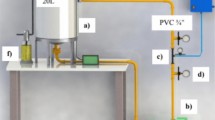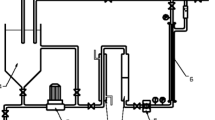Abstract
A pilot scale micro-flocculation and dynasand filtration process was used to pretreat the petrochemical secondary effluent. The suspended solids (SS) and the dissolved organic matter (DOM) removal characteristics were investigated. The results showed that the optimized poly aluminum ferric chloride (PFAC) dosage was 10 mg/L during the experiment. In this dosage period, the SS removal rate was as high as 50.58 % with the effluent SS of 15.38 mg/L when the influent SS was 33.53 mg/L. The COD removal rate was 10.42 %. The DOM fraction with large apparent molecular weight (MW) higher than 3 k was removed more significantly than that of small molecular DOM. Resin fractionation showed that the micro-flocculation and dynasand filtration process could preferentially remove the hydrophobic neutrals (HON) and hydrophobic acids (HOA) of DOM, so it could be suitable as the pretreatment unit. When oxidized by catalytic ozonation, the ozone consumption of COD removal for filtrated effluent was 1.2 g-O3/g-COD while it was 1.6 g-O3/g-COD for untreated petrochemical secondary effluent, saving 25 % of ozone consumption. The micro-flocculation and dynasand filtration is a suitable pretreatment process for petrochemical secondary effluent, especially when the subsequent unit is the catalytic ozonation process.








Similar content being viewed by others
References
Altmann, J., Sperlich, A., & Jekel, M. (2015). Integrating organic micropollutant removal into tertiary filtration: combining PAC adsorption with advanced phosphorus removal. Water Research, 84, 58–65.
APHA. (2005). Standard methods for the examination of water & wastewater. Washington, DC: American Public Health Association.
Bar-Zeev, E., Belkin, N., Liberman, B., Berman, T., & Berman-Frank, I. (2012). Rapid sand filtration pretreatment for SWRO: microbial maturation dynamics and filtration efficiency of organic matter. Desalination, 286, 120–130.
Botalova, O., Schwarzbauer, J., Frauenrath, T., & Dsikowitzky, L. (2009). Identification and chemical characterization of specific organic constituents of petrochemical effluents. Water Research, 43, 3797–3812.
Chen, T. (2015). Micro flocculation and sand filtration process for the treatment of petrochemical secondary effluent. Master Thesis, Changan University.
Crowe, A. U., Plant, A. L., & Kermode, A. R. (2002). Effects of an industrial effluent on plant colonization and on the germination and post-germinative growth of seeds of terrestrial and aquatic plant species. Environmental Pollution, 117, 179–189.
Dennett, K. E., Amirtharajah, A., Moran, T. F., & Gould, J. P. (1996). Coagulation: its effect on organic matter. Journal of American Water Works Association, 88(4), 129–142.
Guo, J., Peng, Y., Guo, J., Ma, J., Wang, W., & Wang, B. (2011). Dissolved organic matter in biologically treated sewage effluent (BTSE): characteristics and comparison. Desalination, 278, 365–372.
Hende, S. V. D., Beyls, J., Buyck, P. J. D., & Rousseau, D. P. L. (2016). Food-industry-effluent-grown microalgal bacterial flocs as a bioresource for high-value phycochemicals and biogas. Algal Research, 18, 25–32.
Hoigné, J., & Bader, H. (1983). Rate constants of reactions of ozone with organic and inorganic compounds in water-I non-dissociating organic compounds. Water Research, 17, 173–183.
Huang, W. J., & Yeh, H. H. (1997). The effect of organic characteristic and bromide on disinfection by-products formation by chlorination. Environ Sci Health, Part A, 32(8), 2311–2336.
Huang, X., Sun, S., Gao, B., Yue, Q., Wang, Y., & Li, Q. (2015). Coagulation behavior and floc properties of compound bioflocculant–polyaluminum chloride dual-oagulants and polymeric aluminum in low temperature surface water treatment. Journal of Environmental Sciences, 30, 215–222.
Jeong, S., Nguyen, T. V., & Vigneswaran, S. (2011). Submerged membrane coagulation hybrid system as pretreatment to organic matter removal from seawater. Water Science and Technology Water Supply, 11, 352–357.
Jeong, K., Lee, D. S., Kim, D. G., & Ko, S. O. (2014). Effects of ozonation and coagulation on effluent organic matter characteristics and ultrafiltration membrane fouling. Journal of Environmental Sciences, 26, 1325–1331.
Kovalova, L., Siegrist, H., von Gunten, U., Eugster, J., Hagenbuch, M., Wittmer, A., Moser, R., & McArdell, C. S. (2013). Elimination of micropollutants during posttreatment of hospital wastewater with powdered activated carbon, ozone, and UV. Environmental Science and Technology, 47(14), 7899–7908.
Mahvi, A. H., Sheikhi, R., & Naddafi, K. (2003). Total coliforms and turbidity removal of water in the continuous sand filter. Iranian J. Publ. Health, 32(3), 7–13.
Marhaba, T. F., & Van, D. (2000). The variation of mass and disinfection byproduct formation potential of dissolved organic matter fractions along a conventional surface water treatment plant. Journal of Hazardous Materials, 73(3), 133–147.
Marhaba, T. F., Van, D., & Lippincott, L. R. (2000). Changes in NOM fractions through treatment: a comparison of ozonation and chlorination. Ozone Science and Engineering, 22(3), 249–266.
Metcalf, Eddy, I., Mohammad, A. O., & Tchobanoglous, G. (2013). Wastewater engineering: treatment and reuse (5th ed.). New York: McGraw Hill Education Press.
Ministry of Environmental Protection of the People’s Republic of China (MEPPRC) (2014). Environment Statistical Yearbook 2013. Beijing: China Environment Press (in Chinese).
Ministry of Environmental Protection of the People’s Republic of China (MEPPRC) (2015). Emission Standard of Pollutants for Petroleum Chemistry Industry. Beijing: China Environment Press (in Chinese).
Munz, G., Cammilli, R. G. L., & Lubello, C. (2008). Characterization of tannery wastewater and biomass in a membrane bioreactor using respirometric analysis. Bioresource Technol., 99, 8612–8618.
Nguyen, T. V., Jeong, S., Pham, T. T. N., Kandasamy, J., & Vigneswaran, S. (2014). Effect of granular activated carbon filter on the subsequent flocculation in seawater treatment. Desalination, 354, 9–16.
Owen, D., Amy, G., Chowdhury, Z., Paode, R., McCoy, G., & Viscosil, K. (1995). NOM characterization and treatability. Journal of American Water Works Association, 87(1), 46–63.
Pakruam, P., & Wattanachira, S. (2014). Reduction of DOM fractions and their trihalomethane formation potential in surface river water by in-line coagulation with ceramic membrane filtration. Journal of Environmental Sciences, 26, 529–536.
Péerez, T. A., Geissler, G., & Hernandez, F. (2007). Chemical oxygen demand reduction in coffee wastewater through chemical flocculation and advanced oxidation processes. Journal of Environmental Sciences, 19(3), 300–305.
Rubio-Clemente, A., Chica, E., & Peñuela, G. A. (2015). Petrochemical wastewater treatment by photo-Fenton process. Water Air Soil Pollution, 226(3), 61–78.
Tang, X., Wu, Q. Y., Zhao, X., Huang, H., Shi, X. J., & Hu, H. Y. (2014). A fingerprint analysis method for characterization of dissolved organic matter in secondary effluents of municipal wastewater treatment plant. Environmental Science and Pollution Research, 24, 14211–14218.
Tran, N. H., Ngo, H. H., & Urase, T. (2015). A critical review on characterization strategies of organic matter for wastewater and water treatment process. Bioresource Technol., 193, 523–533.
Verma, S., Prasas, B., & Mishra, I. M. (2010). Pretreatment of petrochemical wastewater by coagulation and flocculation and the sludge characteristics. Journal of Hazardous Materials, 178, 1055–1064.
Wang, L. S., Hu, H. Y., & Wang, C. (2007). Effect of ammonia nitrogen and dissolved organic matter fractions on the genotoxicity of wastewater effluent during cholrine disinfection. Environmental Science and Technology, 41(1), 160–165.
Wang, F. H., Hao, H. T., Sun, R. F., Li, S. Y., Han, R. M., Papelis, C., & Zhang, Y. (2014). Bench-scale and pilot-scale evaluation of coagulation pre-treatment for wastewater reused by reverse osmosis in a petrochemical circulating cooling water system. Desalination, 335, 64–69.
Wu, C. Y., Gao, Z., Zhou, Y. X., Liu, M. G., Song, J. M., & Yu, Y. (2015). Treatment of secondary effluent from a petrochemical wastewater treatment plant by ozonation-biological aerated filter. Journal of Chemical Technology and Biotechnology, 90, 543–549.
Wu, C., Zhou, Y., Sun, Q., Fu, L., Xi, H., Yu, Y., & Yu, R. (2016). Appling hydrolysis acidification-anoxic–oxic process in the treatment of petrochemical wastewater from bench scale reactor to full scale wastewater treatment plant. Journal of Hazardous Materials, 309, 185–191.
Xu, Y., Cheng, T., Cui, F., & Shi, W. (2016). Effect of reused alum-humic-flocs on coagulation performance and floc characteristics formed by aluminum salt coagulants in humic-acid water. Chemical Engineering Journal, 287, 225–232.
Yan, M., Wang, D., Ni, J., Qu, J., Chow, C. W. K., & Liu, H. (2008). Mechanism of natural organic removal by polyaluminum chloride: effect of coagulation particle size and hydrolysis kinetics. Water Research, 43, 3361–3370.
Yan, Z., Zhang, Y., Yuan, H., Tian, Z., & Yang, M. (2014). Fish larval deformity caused by aldehydes and unknown byproducts in ozonated effluents from municipal wastewater treatment systems. Water Research, 66, 423–429.
Yeruva, D. K., Jukuri, S., Velvizhi, G., Kumar, A. N., Swamy, Y. V., & Mohan, S. V. (2015). Integrating sequencing batch reactor with bio-electrochemical treatment for augmenting remediation efficiency of complex petrochemical wastewater. Bioresource Technology, 188, 33–42.
Zenker, J. L. A., Krahnstover, T., Boehler, M., Baggenstos, M., Koch, G., & Wintgens, T. (2016). Upgrade of deep bed filtration with activated carbon dasage for compact micropollutants removal from wastewater in technical scale. Water Research, 94, 246–256.
Zucker, I., Lester, Y., Avisar, D., Hübner, U., Jekel, M., Weinberger, Y., & Mamane, H. (2015). Influence of wastewater particles on ozone degradation of trace organic contaminants. Environmental Science and Technology, 49, 301–308.
Acknowledgments
The work is financially supported by the China special S&T project on treatment and control of water pollution (2012ZX07201-005) and the National Natural Science Foundation of China (51208484).
Author information
Authors and Affiliations
Corresponding authors
Rights and permissions
About this article
Cite this article
Wu, C., Wang, Y., Zhou, Y. et al. Pretreatment of Petrochemical Secondary Effluent by Micro-flocculation and Dynasand Filtration: Performance and DOM Removal Characteristics. Water Air Soil Pollut 227, 415 (2016). https://doi.org/10.1007/s11270-016-3118-2
Received:
Accepted:
Published:
DOI: https://doi.org/10.1007/s11270-016-3118-2




